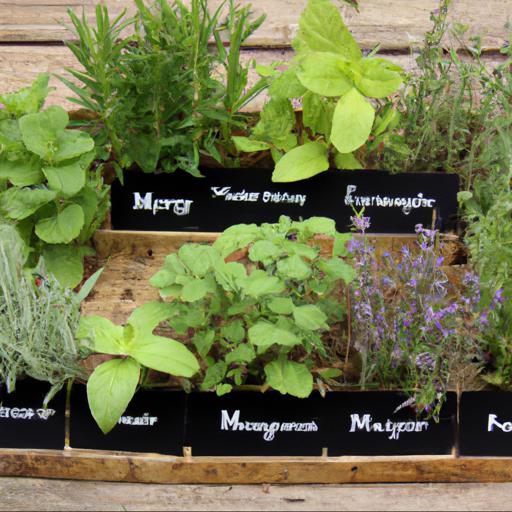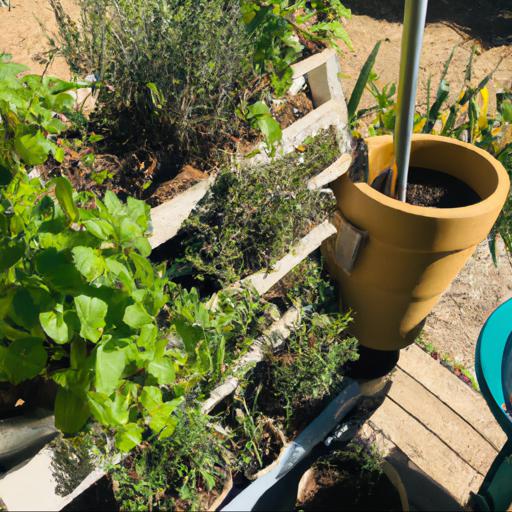Are you looking for a way to bring the healing power of nature into your garden? Growing healing garden herbs can be a great way to do just that. Herbs have been used for centuries to help treat a variety of ailments, and adding them to your garden can be a great way to get the most out of the healing benefits they offer.
In this blog, we’ll discuss some of the best healing garden herbs to grow, as well as tips on how to care for them. With a little bit of effort, you can enjoy the healing power of herbs in your own garden.
Benefits of growing healing garden herbs

Gardening and growing plants have long been associated with health and wellbeing, and growing healing garden herbs can provide a whole range of benefits for both your physical and mental health. From increasing relaxation to providing valuable nutrients, herbs can be a great way to give your garden a boost. When planning your garden herbs, it’s important to think about what you hope to achieve.
Are you looking to reduce stress and provide calming aroma’s? Or are you looking to use the herbs to improve digestion and boost your immune system?
Once you know what you’re hoping to achieve, you can start selecting which herbs to grow. Herbs such as peppermint and chamomile can help relax your mind, while lavender is believed to help with depression and insomnia. Parsley is great for detoxifying your liver and kidneys, while rosemary can potentially boost your memory.
Sage is another great option as it is high in antioxidants, as well as vitamins A and E. In addition to these physical benefits, herbs can also bring a wonderful scent to your garden.
Sweet basil for example can help soften the smell of the soil, while thyme is known for its aromatic and air-purifying properties. And don’t forget some classic herbs like rosemary, oregano and thyme to add a wonderful aroma to your cooking. Whatever your reasons for planting healing garden herbs, these plants certainly provide an abundance of benefits.
Not only do they provide an important source of nutrients, but can also help reduce stress and boost your mental health. So why not find some great herbs to grow in your garden today and start the journey towards a healthier life.
Types of healing garden herbs to grow

It’s easy to add a touch of healing and wellness to your garden by growing healing herbs. There are a variety of medicinal herbs that can be grown in a garden and have amazing health benefits. From aiding in stress relief to calming anxiety and boosting immunity, there are numerous benefits to growing healing garden herbs.
Rosemary is one of the most popular healing garden herbs to grow. It’s a perennial herb that has been used to aid digestion and enhance memory, while also having antiviral and antibacterial properties.
The leaves can be added to dishes to give a unique and fragrant flavor, and the woody stems can be used to make teas and tinctures. Plus, rosemary has a pleasant aroma which can help reduce stress and promote relaxation.
Another healing garden herb to grow is garlic. It provides a range of health benefits such as helping to fight infection and boost immunity thanks to its high levels of allicin, a compound that has antibiotic, antifungal and antiviral properties. Plus, the preparation of garlic doesn’t have to be labor intensive; it can just be chopped up and added to dishes for an intense flavor.
One of the most underrated healing herbs is turmeric. This spice can be easily grown in containers or a herb garden, and has an incredible list of healing powers due to its curcumin content.
It can help reduce inflammation, boost immunity, aid digestion, and has antifungal and antibacterial properties. You can add it to dishes, steep it in hot water to make a tea, or make a paste for topical application. From rosemary to garlic and turmeric, there are countless healing garden herbs to grow.
Whether you want to add flavor to your dishes, improve your overall health, or simply add a touch of tranquility to your garden, adding a few healing herbs can enhance your wellbeing.
How to plant and care for healing garden herbs

Planting and caring for healing garden herbs can be an extremely rewarding endeavor for any gardener. Not only do these herbs provide us with delicious, nourishing dishes, but they can also benefit us by aiding in disposition and physical health from the multiple benefits of their therapeutic properties. Growing these herbs can provide valuable knowledge, and is a great way to enhance both the aesthetic and functional character of your garden.
To get started on a healing garden, one must first choose the appropriate herbs and plants. Among the most popular and widely used healing herbs are rosemary, thyme, chamomile, lemon balm, peppermint, and lavender.
Rosemary is an excellent antiseptic, antispasmodic, and soothing agent. It is great for headaches and can be used in treating colds and flus.
Thyme is another highly revered herb and is often used to treat sore throats and chest infections. Chamomile can help reduce inflammation, while peppermint can help with stomach problems and aid digestion. Lemon balm, on the other hand, is often used to help with anxiety and improve sleep quality.
Lastly, lavender is a great herb to soothe stress and headaches. When selecting the ideal spot to plant the herbs, it is best to provide a location that is well lit, receives at least six hours of sunlight per day, and has a well-draining soil structure. If the soil is too compact and dense, creating a raised bed offers plenty of flexibility for the type of soil used and for drainage.
Once the soil is prepped, it is time to plant. Depending on the specific herb, it may be necessary to start your plants indoors or purchase starter plants from the nursery.
Although different herbs have various planting instructions and times, typically a good rule of thumb is to plant seeds one-quarter to one-half inch deep and three inches apart in rows. It is also necessary to implement appropriate pruning and weeding practices as the herbs start to grow and mature. It is also vitally important to make sure they receive adequate water every few days to ensure optimal growth and health. By planting and caring for healing garden herbs, you can practice sustainable gardening and reap the therapeutic rewards of self-grown natural medicine. With careful selection and consistent attention, you can look forward to abundant, healthy herbs that bring both physical and mental health benefits.
Tips for growing healing garden herbs successfully
Gardening is a rewarding task, as not only is it beneficial for your wellbeing but it also gives you the opportunity to grow your own healing herbs. Expanding your gardening skills by learning how to successfully grow healing garden herbs is both fun and rewarding. With a little know-how and patience, you can cultivate an herb-filled garden that will produce nutritious and medicinal plants in no time.
When growing healing herbs, it’s important to choose an area that gets plenty of sunlight, in order to ensure the plants are well-nourished. An ideal sun exposure for the majority of herbs is six to eight hours per day.
Most herbs prefer good drainage, so make sure the area you’re growing them in can offer this. Pre-packaged herbs you purchase at the store may take time to get settled, so give them some extra TLC and make sure they are optimally placed in the garden.
To receive optimal growth, make sure to fertilise your herbs regularly. A natural fertiliser like compost can be great here, as well as a slow-release organic mulch. Keep in mind that some herbs may require more attention than others, such as those prone to disease, so be sure to research what each requires.
Additionally, make sure to harvest your herbs in the morning, as this is the time when their essential oils are highest. Depending on what you’re using your herbs for, you might want to use them even fresh from the garden. Making sure to take proper care of your plants throughout their growth cycle is essential for getting the highest yield and the best results.
Growing healing garden herbs can be a fun and educational experience, allowing gardeners to learn more about their properties and uses. Being organized and keeping up with the maintenance of your herbs will help ensure you have beautiful plants that are healing and nutritious.
Once you’ve taken the first steps, you’ll be ready to turn your garden into an herb-filled paradise.
Our video recommendation
Conclusion
This article explored the many healing herbs that can be grown in a garden. From lavender and chamomile to rosemary and sage, these herbs have a variety of health benefits and make a great addition to any healing garden.
With proper care and attention, these herbs can provide a natural way to improve your health and wellness.
FAQ
What are the benefits of growing healing garden herbs?
The benefits of growing healing garden herbs include providing natural remedies for common ailments, improving air quality, and adding beauty and fragrance to the garden. Growing herbs can also provide a source of income, as they can be sold at farmers markets or used to make herbal products.
What are some common healing garden herbs?
Common healing garden herbs include lavender, chamomile, rosemary, thyme, mint, oregano, sage, and basil.
How do you care for healing garden herbs?
To care for healing garden herbs, water them regularly, keep them in a sunny spot, and fertilize them with a balanced fertilizer every few weeks. Prune them regularly to encourage new growth and harvest the leaves as needed.
What are the best conditions for growing healing garden herbs?
The best conditions for growing healing garden herbs include full sun, well-draining soil, and consistent watering. Additionally, herbs should be planted in raised beds or containers to ensure proper drainage and to protect them from pests.
How do you harvest healing garden herbs?
Harvesting healing garden herbs can be done by cutting the stems of the herbs with scissors or pruning shears. It is best to harvest herbs in the morning after the dew has dried, but before the heat of the day. When harvesting, take only the top two or three inches of the herb and leave the rest to continue to grow.
What are some recipes that use healing garden herbs?
Some recipes that use healing garden herbs include: Herbal Tea, Herbal Infused Honey, Herbal Vinegar, Herbal Pesto, Herbal Soup, Herbal Salad Dressing, Herbal Syrup, Herbal Butter, Herbal Compound Butter, Herbal Salt, Herbal Spice Rub, Herbal Infused Oil, and Herbal Infused Cocktails.

